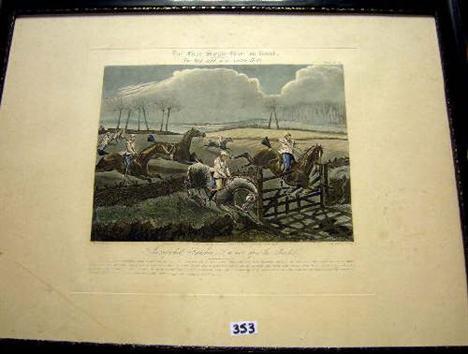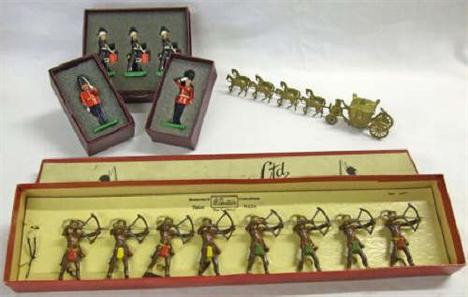We found 596780 price guide item(s) matching your search
There are 596780 lots that match your search criteria. Subscribe now to get instant access to the full price guide service.
Click here to subscribe- List
- Grid
-
596780 item(s)/page
A group of three silver pair cased pocket watches the first of large size, the circular enamel dial with 'JOSEPH WALTON' for the numerals, subsidiary seconds hand, the verge movement inscribed M Tobias and Co. London; another by Robert Ray Liverpool; another by J Ellard Stockingford; and a 9ct gold cased keyless wind open faced pocket watch; a plain silver csed demi-hunter cased pocket watch (5)
James Bond: Gilbert silver battery-operated Secret Agent's Aston-Martin Action Car in original box 290mm, E, box G. :. This model is one of the first sold by Gilbert after loosing the official James Bond merchandising licence. :. A similar lot sold Christie's 007 James Bond 17 September 1998 lot 3
Triang: RD3 Tank Goods Set, RS1 Princess Victoria Passenger Set, 0-6-0 Goods Set, SR and BR coaches, freight stock, track-cleaning wagon, signal, control unit, Footbridge, water crane, kiosk, hut, fencing units, telegraph poles, platform units, servicing leaflets, 'The First Ten Years' book; Hornby Railways SR Sir Dinadan and two coaches, majority boxed, F-VG, boxes P-F, some F-G Scottie Model Railway paperback
United Kingdom Coronation Anniversary Collection 1953-2003, with presentation pack and certificates, Queen Elizabeth The Queen Mother Five Pounds coin and Five Pounds banknote set, The Golden Steam Age Jersey 2006 Five Pound Silver Proof coin with certificate, three 2007 Diamond Wedding Crowns with packaging and certificates, and a first Day of Issue UK One Pound coin
A set of three First World War medals awarded to Private W E Rant of the Berkshire Yeomanry, the 1914/18 medal the Great War medal, the 1914/15 Star, complete with a collection of related memorabilia including Private Rant's tunic buttons, his own spoon marked with his name and number, his pen knife, army issue cigarette lighter, various letters that he wrote home etc.
HENRY HERBERT LA THANGUE R.A. (BRITISH, 1859-1929) A Sussex Hayfield at Graffham, 1912, signed 'H. H. LATHANGUE' lower left, oil on canvas, 25 ½" x 29 ¼" (see illustration) Provenance: Purchased by Moses Nightingale Esq. (possibly from the Leicester Galleries, London, 1914); thence by descent Exhibited: London, Leicester Galleries, Exhibition of Pictures by H. H. La Thangue, R.A., April 1914, no. 41 Brighton, City Art Gallery and Museum, Memorial Exhibition of Works by the Late H. H. La Thangue R. A., September 1930, no. 24 Literature: Walter Sickert, 'Mr La Thangue's Paintings', The New Age, vol XV, no. 1, 7 May 1914, p. 18 Anon, Watercolours and Oils at Hazeldene, Crawley, Sussex, 1919, no. 108 as Sussex Hayfield at Graffham, Sussex, 1912 Osbert Sitwell ed., A Free House! Being the Writings of Walter Richard Sickert, 1947 (MacMillan), p. 272 Anna Gruetzner Robins, Walter Sickert: The Complete Writings on Art, 2002, (Oxford University Press), pp. 364-365 While he spent his winters during the Edwardian years in Provence and the regions of northern Italy, La Thangue returned to England to work in the fields around his home at Graffham in Sussex between hay cutting in June and the grain and fruit harvests of September. He had moved the relatively short distance from Bosham to Graffham in 1898 because the new location offered a greater range of possibilities, and immediately he began a series of striking figure pieces with Love in the Harvest Field, shown at the Royal Academy in 1899 (unlocated). La Thangue first moved to Sussex in 1890, on the advice of James Charles, who also lived at Bosham. Charles, a figure and landscape painter from Warrington in Cheshire, shared La Thangue's early Bradford patrons. Both artists looked to France for inspiration and both were influenced by work of Bastien-Lepage and Léon Lhermitte, also popular with West Yorkshire collectors. Lhermitte in particular set out to document la vie rustique and by 1900, was in the midst of a long series of harvest scenes that La Thangue would have been familiar with (fig 1). Known primarily as a figure painter, La Thangue closely observed the freer and more informal style in Charles' harvest scenes around the turn of the century. Suspicious of the picturesque seductions of his more conventional contemporaries like Alfred East and David Murray, he slowly developed his own approach to landscape painting after he moved away from Bosham. By the time of his solo exhibition at the Leicester Galleries in 1914, this process was complete and the rich texture of works like A Sussex Hayfield at Graffham separates it from the looser paint structures of Charles's Windy Weather, (fig 2). Where most landscape painters, including Charles and Lhermitte, favoured open country, La Thangue used foreground trees to help place his figure and take the eye successfully to the hay-cart in the middle distance. Moses Nightingale, a Sussex corn merchant, having purchased two pictures, On Lavington Down and A Ligurian Mill Race, shown at the Royal Academy in 1901 and 1905 respectively, returned to collecting around 1914. La Thangue, who by then had secured full membership of the Royal Academy, was staging a solo exhibition at the Leicester Galleries. An earlier generation of Nightingales, hailing from Rotherham, had donated a substantial collection to the town, including an early Landscape Study by the artist. However, Moses Nightingale was to become La Thangue's most important patron, listing twenty-three works in a catalogue of the watercolours and oils at Hazeldene, his house in Crawley. Following the painter's death, Nightingale lent generously to his memorial exhibition at Brighton Art Gallery and the Royal Academy 'Late Members' exhibition in 1933. Thereafter he split his collection between members of his family. Coming three and half years after Roger Fry's celebrated Manet and the Post-Impressionists exhibition, and coinciding with the scandalous exposure of the Vorticists and the Italian Futurists, La Thangue's Leicester Gallery landscapes must have looked traditional, even by Camden Town School standards. Despite their compositional strength, his landscapes were greeted with faint praise in The Times (20 April 1914, p. 12) and attacked by Laurence Housman in The Manchester Guardian (18 April 1914, p. 10). While reservations were also expressed by The Athenaeum and The Connoisseur, The Academy praised La Thangue's honesty and the 'daring' of his 'handling and mastery of colour' (McConkey, 1978, p. 13). It was Walter Sickert however, who cited the present work in a glowing review that swept away all reference to the current turmoil in contemporary art. What would have appealed to Sickert in the present work? In his review, Sickert referred to Monet and Cezanne, now familiar to British audiences. La Thangue was not their follower, but he did possess their dedication to developing 'a series of colour relations…grading from russet towards ruby' on which he was able to 'build…a series of beautiful and interesting sensations of nature'. This was his unique discovery, and it did not depend on clever quotation from 'the gamut of Monet'.
Wanostrocht, Nicholas, Felix on the bat; being a scientific inquiry into the use of The Cricket Bat; together with the history and use of the Catapulta. Also the laws of cricket, as revised by the Marylebone Club,1845. lst ed, Baily Brothers, Cornhill. Seven hand colour litho plates, three uncoloured spotting and staining, contents loose, in original blind stamped cloth, soiled. the first cricket book to be illustrated with colour lithographs
A pair by Abraham Jansz Storck (1644-1708) The Dutch Royal Yacht with elegant company on board docking at a jetty in a swell, with figures on the shore and fishing boats out to sea; A Yacht and other vessels moored on the shore with many figures loading supplies and preparing nets, Dutch warships at anchor beyond. A pair both signed, the first also inscribed fecit Both oil on canvas Each 31.5 x 42.5cm; 12¼ x 16¾in (2) Provenance: From the collection of the 9th Duke of Newcastle and thence by descent. Both lined
Chinese School, circa 1820 The Factories Canton, Annunghoy Fort, Maccao [sic] and Anchorage Whampoa, A set of four, oil on copper Each 10.5cm x 14.5cm (4) Uncommonly fitted as pairs into two red morocco cases, these show a series of views painted circa 1820. The front in Canton was constantly changing throughout the first half of the 19th century but this view is consistent with many shown in The Decorative Arts of the China Trade, by Carl L Crossman (Antiques Collectors Club). Annunghoy Fort was in the Boca Tigris in the approach to Canton. Macao, here spelt Maccao, was first settled by the Portuguese in the 16th century is now a Special Administrative Region of the People's Republic of China. Whampoa was an anchorage with the famous nine stage pagoda, visible in this picture.
Eva Gonzales (1849-1883) Vase De Fleurs Oil on canvas laid on panel Signed lower right 59cm x 72cm Provenance: Purchased from Arthur Tooth & sons by The Right Hon. Lord Radcliffe, P.C., C.B.E in 1961 for 3200 pounds and thence by descent Eva Gonzales (19th April 1849-6th May 1883) Eva Gonzalès first received critical acclaim at the age of twenty when she exhibited three paintings and was the subject of another by Edouard Manet, at the Paris Salon in 1870. Despite being known as never exhibiting with the Impressionist painters in their controversial exhibitions, she was considered part of the group due to her painting style. Gonzales met Manet in 1869, and he became her main influence in the arts, although her mother was an accomplished musician and her father was a well known novelist. She became Manet's first and only student and became a close friend. Her career was cut short when she died in childbirth at the age of thirty-four, exactly six days after the death of her teacher, Manet.
Bayardi, Ottavio Antonio. Delle Antichita Di Ercolano, eight volumes, Napoli 1757-1792. Worn and mis-matched quarter calf, 1 folding map, 5 folding plates, 616 full page plates plus engraved chapter headers and footers and engraved capitals. Damp marking to first half of volume six plus occassional minor marking to inner margins of some other volumes, folio.
Jones, Owen Glynee. Rock-Climbing in the English Lake District, first edition, London Longmans, Green, 1897. Rubbed cloth, illustrated, octavo, plus Bechtold, Fritz. Nanga Parbat Adventure 1935; Ruttledge, Hugh. The Unfinished Adventure, 1937; Hunt, John. The Ascent of Everest, 1953, signed. (4)
Livingstone, David. Missionary Travels and Researches in South Africa, first edition, London John Murray, 1857. Cloth, maps and illustrations, octavo, plus Lugard, Captain F. D. The Rise of Our East African Empire, two volumes, first edition, Edinburgh William Blackwood, 1893. Marked cloth, author's signed presentation inscription to Sir Percy Anderson, maps and illustrations, octavo. (3)
Raine, James. Saint Cuthbert. With an Account of the State in which his Remains were Found upon the Opening of his Tomb in Durham Cathedral in the Year MDCCCXXVII, first edition, Durham Geo. Andrews, 1828. Later half morocco, quarto, plus Raine, Angelo. Mediaeval York, London John Murray, 1955. Morocco, presentation inscription, plus three others related. (6)
Morison, Stanley & Day, Kenneth. The Typographic Book 1450-1935, first edition, London Ernest Benn, 1963. Dust wrapper, slip case, quarto, plus Ames, Joseph. Typographical Antiquities or the History of Printing in England, Scotland and Ireland, four volumes, Hildesheim, George Olans, 1969. Cloth, octavo, plus other volumes related. (30)
Aldin, Cecil. A Sporting Garland, London Sands & Co., no date. Boards, oblong quarto, colour illustrations, plus Every-Day Characters, first edition, London Keegan Paul, 1896. Picture boards, octavo, plus The Dog Who Wasn"t What He Thought He Was, first edition, London Raphael Tuck, no date, plus others illustrated by Aldin. (shelf)
-
596780 item(s)/page





























![Chinese School, circa 1820 The Factories Canton, Annunghoy Fort, Maccao [sic] and Anchorage Whampoa, A set of four, oil on c](http://lot-images.atgmedia.com/SR/10011/2748819/114-173-10011_468x382.jpg)
